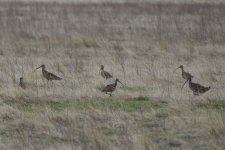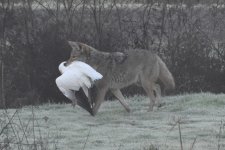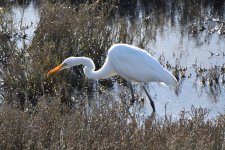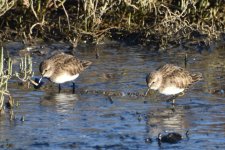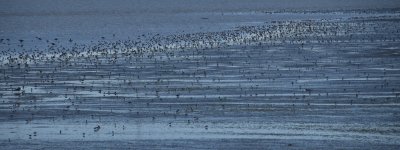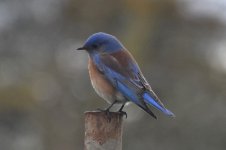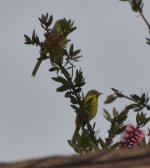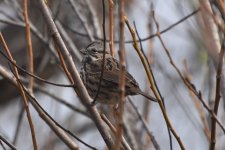1 January 2024
I have set a birding goal for 2024: I shall try to see 400 species of birds in California during the year. I think it is quite possible. Possibly some people do it every year. Without particularly trying, I came close to that mark with in 2022 with 380 species. That year I did not visit the far north of the state, or sagebrush habitats, or do a pelagic trip in Southern California, each of which could have produced at least a few species that I missed, and I missed some species in places that I did visit. The real question may be: Can I do it without blowing up my carbon footprint trying to chase down every vagrant that wanders into the state?
I had a good start today. I was awakened at 3:00 AM by the sound of a Great Horned Owl calling. When I left the house hours later it was still calling, as were Wild Turkeys. At Aptos Creek Mouth, on the beach south of Santa Cruz, there have been two rare (for California) gulls: Black-headed and Laughing. I went to look for them this morning. The Laughing Gull was quite cooperative, but the Black-headed was moving around and I could not catch up with it. The beach was very busy on this holiday morning. No swimmers, but a few surfers and many people walking their dogs or children, and many probably checking on the damage done and the debris cast-up by recent storms. The dogs, especially those off leash, kept the birds from settling too long in one place. There were a variety of other gulls there (Western, Glaucous-winged, California, Ring-billed, Short-billed, and Iceland) and 20 other species to put on the year list.
I then went to West Cliff Drive in Santa Cruz where there is some lovely rocky shoreline that usually has most of the local rockpipers this time of year, but the tide was very high, the rocks mostly covered with water, and the birds mostly elsewhere. The sea stack at Natural Bridges State Beach did host Brown Pelicans; Brandt’s, Pelagic, and Double-crested Cormorants; more gulls (including Heermann’s); and a couple each of Black Oystercatchers and Black Turnstones. Out on the water were some of the local oceanic species: Surf Scoter, Red-breasted Merganser, Common Goldeneye, Common and Red-throated Loons. A Forster’s Tern flew by.
I decided to head inland next and went to Quail Hollow County Park for some terrestrial birding. It was rather slow there, but I did pick-up some of the common land birds of the region. Back home in time to watch some college football. That’s American football to those of you in the rest of the world, and the college version of the game is a big deal here. The good guys won.
In all I ended up with 61 species for the day: Canada Goose, Mallard, Surf Scoter, Common Goldeneye, Common Merganser, Red-breasted Merganser, Wild Turkey, Red-throated Loon, Pacific Loon, Common Loon, Horned Grebe, Western Grebe, Brown Pelican, Brandt’s Cormorant, Double-crested Cormorant, Pelagic Cormorant, Snowy Egret, Black-crowned Night-Heron, Turkey Vulture, Red-tailed Hawk, American Coot, Black-bellied Plover, Black Oystercatcher, Willet, Marbled Godwit, Black Turnstone, Sanderling, Laughing Gull, Heermann’s Gull, Short-billed Gull, Ring-billed Gull, Western Gull, California Gull, Iceland (Thayer’s) Gull, Glaucous-winged Gull, Forster’s Tern, Rock Pigeon, Great Horned Owl, Anna’s Hummingbird, Belted Kingfisher, Acorn Woodpecker, Nuttall's Woodpecker, Northern Flicker, Black Phoebe, Steller’s Jay, California Scrub-Jay, American Crow, Common Raven, Chestnut-backed Chickadee, Bewick’s Wren, American Robin, Wrentit, European Starling, Yellow-rumped Warbler, Spotted Towhee, California Towhee, Song Sparrow, White-crowned Sparrow, Dark-eyed Junco, Brewer’s Blackbird, and House Finch. If I had not spent so much time chasing the Black-headed Gull I would surely have added to this list, but anything I missed today I should be able to see in the days to come.
I have set a birding goal for 2024: I shall try to see 400 species of birds in California during the year. I think it is quite possible. Possibly some people do it every year. Without particularly trying, I came close to that mark with in 2022 with 380 species. That year I did not visit the far north of the state, or sagebrush habitats, or do a pelagic trip in Southern California, each of which could have produced at least a few species that I missed, and I missed some species in places that I did visit. The real question may be: Can I do it without blowing up my carbon footprint trying to chase down every vagrant that wanders into the state?
I had a good start today. I was awakened at 3:00 AM by the sound of a Great Horned Owl calling. When I left the house hours later it was still calling, as were Wild Turkeys. At Aptos Creek Mouth, on the beach south of Santa Cruz, there have been two rare (for California) gulls: Black-headed and Laughing. I went to look for them this morning. The Laughing Gull was quite cooperative, but the Black-headed was moving around and I could not catch up with it. The beach was very busy on this holiday morning. No swimmers, but a few surfers and many people walking their dogs or children, and many probably checking on the damage done and the debris cast-up by recent storms. The dogs, especially those off leash, kept the birds from settling too long in one place. There were a variety of other gulls there (Western, Glaucous-winged, California, Ring-billed, Short-billed, and Iceland) and 20 other species to put on the year list.
I then went to West Cliff Drive in Santa Cruz where there is some lovely rocky shoreline that usually has most of the local rockpipers this time of year, but the tide was very high, the rocks mostly covered with water, and the birds mostly elsewhere. The sea stack at Natural Bridges State Beach did host Brown Pelicans; Brandt’s, Pelagic, and Double-crested Cormorants; more gulls (including Heermann’s); and a couple each of Black Oystercatchers and Black Turnstones. Out on the water were some of the local oceanic species: Surf Scoter, Red-breasted Merganser, Common Goldeneye, Common and Red-throated Loons. A Forster’s Tern flew by.
I decided to head inland next and went to Quail Hollow County Park for some terrestrial birding. It was rather slow there, but I did pick-up some of the common land birds of the region. Back home in time to watch some college football. That’s American football to those of you in the rest of the world, and the college version of the game is a big deal here. The good guys won.
In all I ended up with 61 species for the day: Canada Goose, Mallard, Surf Scoter, Common Goldeneye, Common Merganser, Red-breasted Merganser, Wild Turkey, Red-throated Loon, Pacific Loon, Common Loon, Horned Grebe, Western Grebe, Brown Pelican, Brandt’s Cormorant, Double-crested Cormorant, Pelagic Cormorant, Snowy Egret, Black-crowned Night-Heron, Turkey Vulture, Red-tailed Hawk, American Coot, Black-bellied Plover, Black Oystercatcher, Willet, Marbled Godwit, Black Turnstone, Sanderling, Laughing Gull, Heermann’s Gull, Short-billed Gull, Ring-billed Gull, Western Gull, California Gull, Iceland (Thayer’s) Gull, Glaucous-winged Gull, Forster’s Tern, Rock Pigeon, Great Horned Owl, Anna’s Hummingbird, Belted Kingfisher, Acorn Woodpecker, Nuttall's Woodpecker, Northern Flicker, Black Phoebe, Steller’s Jay, California Scrub-Jay, American Crow, Common Raven, Chestnut-backed Chickadee, Bewick’s Wren, American Robin, Wrentit, European Starling, Yellow-rumped Warbler, Spotted Towhee, California Towhee, Song Sparrow, White-crowned Sparrow, Dark-eyed Junco, Brewer’s Blackbird, and House Finch. If I had not spent so much time chasing the Black-headed Gull I would surely have added to this list, but anything I missed today I should be able to see in the days to come.
Attachments
-
 Brewer's Blackbird 2024-01-01 a.JPG1 MB · Views: 17
Brewer's Blackbird 2024-01-01 a.JPG1 MB · Views: 17 -
 Laughing Gull 2024-01-01 b.JPG850.9 KB · Views: 17
Laughing Gull 2024-01-01 b.JPG850.9 KB · Views: 17 -
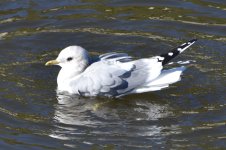 Short-billed Gull 2024-01-01.JPG507.4 KB · Views: 16
Short-billed Gull 2024-01-01.JPG507.4 KB · Views: 16 -
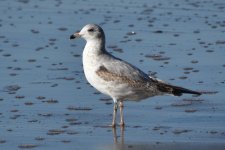 Ring-billed Gull 2024-01-01 a.JPG459.9 KB · Views: 15
Ring-billed Gull 2024-01-01 a.JPG459.9 KB · Views: 15 -
 Marbled Godwit 2024-01-01 b.JPG520.9 KB · Views: 14
Marbled Godwit 2024-01-01 b.JPG520.9 KB · Views: 14 -
 Marbled Godwit 2024-01-01 c.JPG2.1 MB · Views: 16
Marbled Godwit 2024-01-01 c.JPG2.1 MB · Views: 16 -
 Common Merganser 2024-01-01 c.JPG476.4 KB · Views: 17
Common Merganser 2024-01-01 c.JPG476.4 KB · Views: 17










